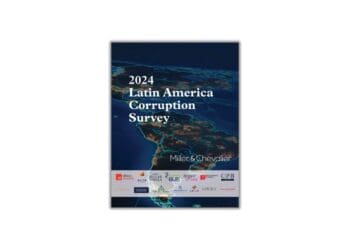Conducting thorough due diligence can be tedious work, but (as with most endeavors) putting in the effort yields the best results. Jim Nortz outlines a three-step process for effectively assessing intermediaries.
Read Part 2 here.
I am a terrible scientist.
At least that’s the conclusion I reached when I worked as a college co-op student at the Xerox Laboratories in Webster, New York many years ago. As a mechanical engineering student at the Rochester Institute of Technology, I was required to complete five co-op blocks in addition to four years of classes. The second co-op job I got was with Dr. Fred Schmidland, a brilliant theoretical physicist. One of the things Dr. Schmidland asked me to do was to test the electrical properties of several films that were deposited on a plastic plate. This experiment required me to sit in a laboratory by myself and perform repetitive measurements for hours on end. Each time I took a measurement, I noted the result on a graph. I hated this work. It was tedious. It was boring. As a consequence, I worked hard to finish this chore so I could move on to more interesting work.
At the end of the second day of making hundreds of measurements, I had produced a graph with a beautiful curve sloping gently upward. When I showed the results of my work to Dr. Schmidland, he rubbed his chin and told me that this was a very unexpected result. He asked that I perform the experiment again. When I did so with extra care, I produced a graph that went in the opposite direction from the first. This was more in line with the anticipated properties of the material I was testing. I had fallen victim to a tendency that is common to all of us: bias. I was so interested in bringing the experiment to a conclusion that when I saw a trend in the data, I unwittingly recorded erroneous results. Fortunately for Xerox, Dr. Schmidland was there to provide expert, independent oversight of the experiment and ensured an accurate result.
When deciding whether to onboard a new intermediary, your business colleagues likely don’t intend to put the company in jeopardy by contracting with an intermediary with a checkered past. But, like me in the laboratory, they may have a strong bias toward consummating such a deal and be blind to the potential risks associated with doing so. Consequently, you should supplement your first-party intermediary due diligence program with third-party due diligence and corporate oversight by qualified, disinterested parties to make sure your company gets this right every time.
The following is a high-level description of the three steps you should take to get this done.
Step 1: Identify the Company’s Intermediaries
This first step may seem obvious, but in my experience, companies that do not have an effective intermediary anti-corruption program lack an accurate and up-to-date database of their intermediaries across the globe. If this is the case at your firm, you’ve got to get this done before you can make any meaningful progress in implementing such a program. You need to have line of sight to all company intermediaries in order to effectively manage intermediary corruption risk associated with both existing and new intermediaries.
In large multinational organizations, gathering intermediary data is not a trivial exercise. To complete this task, you will likely have to work across countries and business units to obtain data associated with hundreds – or, perhaps, thousands – of business entities. In addition to obtaining the name, address and contact information of active intermediaries, you should also gather the following data:
- The names of the intermediary’s senior leaders;
- The status of written contracts with the intermediary;
- The intermediary type (e.g., import/export broker, contractor, distributor, sales agent, consultant); and
- For distributors and sales agents, annual sales.
While you are working with your businesses to perform this work, I recommend you also get started on Step 2, detailed below.
Step 2: Contract with a Third-Party Due Diligence Provider
Third-party due diligence providers are firms with a global reach that can perform various levels of Intermediary due diligence on the company’s behalf. Three big players in this space I have worked with are Trace International, NAVEX’s Risk Rate and Securimate/Steel International. Each has its strengths and weaknesses, and there are also others providing similar services that you might consider.
When shopping for such a provider, I recommend you form a multidisciplinary team comprised of IT professionals, the legal department, the compliance department and business leaders to help you learn as much as you can about the provider’s strengths and limitations and to ensure you select one that best suits your business needs. Given the significant administrative transaction costs associated with switching from one vendor to another, it is very important to kick the tires hard before making your purchase.
Regardless of which third-party due diligence provider you select, you should seek one that, at a minimum, has the following attributes:
- Global reach and the ability to function in multiple languages;
- A system that permits an unlimited number of company users;
- The capacity to search all relevant government databases and media sources necessary to serve your business needs;
- An electronic case management system to house all intermediary due diligence data that can be populated via electronic transfer from an Excel spreadsheet or company database;
- Capability of uploading first-party due diligence reports, audits and other documents into the system;
- Capability of permitting you to customize due diligence questionnaires;
- Capability of distributing due diligence questionnaires to intermediaries electronically in multiple languages;
- Capability to alert company personnel when due diligence questionnaires are completed;
- Capability of allowing users to order varying levels of due diligence online via a case management system;
- Quick turnaround of due diligence reports;
- Due diligence reporting formats that are user-friendly and informative;
- Capability to alert company personnel when due diligence reports are completed;
- Due diligence reporting that clearly identifies red flags;
- Capability of recording red flag resolutions;
- Clear and meaningful dashboards;
- Internal search capability;
- Capability of continuous monitoring of government databases for intermediary red flags with the capacity to filter out false positives;
- Auditability with a clear record of data entries and changes made in the system and the identity of the individuals making the change;
- Permits your company to maintain ownership of all intermediary data with the capability of porting it to your firm for backup, reporting purposes or in the event you terminate the services or switch to a new third-party due diligence provider.
- Capability of interfacing with the company’s ERP to permit a single data entry point for new intermediaries via the company ERP; and
- Capability of tracking intermediary contract status and notifying company personnel when contracts are nearing expiration dates.
Once you have selected a third-party due diligence provider, work with your interdisciplinary team to configure the system and develop data entry protocols that will meet your business needs. Perhaps it goes without saying, but you’ll save a significant amount of time if you seek the assistance of an independent consulting firm that has performed this work in the past.
Step 3: Develop and Implement Third-Party Due Diligence Policies and Procedures
Regardless of which third-party due diligence provider you select, you will soon find out these systems are not “plug and play.” In addition to taking the necessary steps to configure the system and load your intermediary data, you will need to work with your colleagues to develop and implement policies and procedures to communicate to company personnel when and how intermediary due diligence is to be performed. Such policies and procedures should clearly detail the roles and responsibilities of all individuals and departments that will be called upon to participate in the due diligence process. They should also provide for corporate oversight by a team comprised of legal, compliance and finance and accounting professionals who are charged with regulating all aspects of the intermediary anti-corruption program to ensure the businesses are abiding by the policy and following all procedures. To be effective, this corporate oversight team must have the ability to prevent any commercial transactions with new intermediaries prior to full completion of the due diligence process and contract execution.
Once you finalize and publish these policies and procedures, you will have to also develop and implement a training program for your colleagues to help them understand what is expected of them and how to interact with the third-party due diligence management system. In large, multinational organizations, this is a significant amount of work and will likely take you months just to get off the launching pad.
A sustained training program will be required to fully integrate intermediary due diligence into routine business processes. And, as with any change to business processes, you can expect at least some measure of resistance from your colleagues. This is one reason why getting buy-in from your management team at the outset is so important. Your intermediary anti-corruption program will not survive its infancy without strong and sustained support from top management.
Part 4 will detail best practices in contracting with intermediaries – practices that will serve your business needs and mitigate your intermediary corruption risk.











